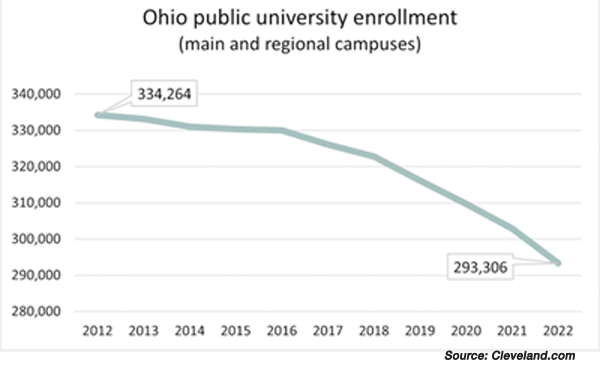Excerpt from the Spring 2024 Extension
 While running for Ohio governor in 1962, James Rhodes said he wanted to establish a public college or university within 30 miles of every Ohioan. After the Republican won office in 1963, new schools opened: Cleveland State in 1964, followed by Wright State in 1967, Northeast Ohio Medical University in 1973 and Shawnee State in 1985. Today Ohio has 14 public universities, 23 community colleges, about 50 independent, nonprofit private schools, and roughly 30 for-profit schools.
While running for Ohio governor in 1962, James Rhodes said he wanted to establish a public college or university within 30 miles of every Ohioan. After the Republican won office in 1963, new schools opened: Cleveland State in 1964, followed by Wright State in 1967, Northeast Ohio Medical University in 1973 and Shawnee State in 1985. Today Ohio has 14 public universities, 23 community colleges, about 50 independent, nonprofit private schools, and roughly 30 for-profit schools.
About 70,000 students were enrolled in Ohio colleges and universities when Rhodes made his pledge. Fifty years later, in 2012, there were about 527,000 enrollees. But the upward trend began to reverse around that time. By 2022, Ohio higher education enrollment dropped to 463,000, according to the Ohio Department of Higher Education.
“We saw a decline from 2012 to 2020 of about 12% in the public sector — both in the four-year and the twoyear [schools],” said Chancellor Mike Duffey of the Ohio Department of Higher Education.
Duffy blames fundamental demographics, declining birth rates nationally and in Ohio, and declining collegegoing rates for the decline. “Fewer students are choosing to go to college after high school.”
According to the Pew Research Center, in 2022, 39% of 18- to 24-year-old men who graduated from high school were enrolled in college, down from 47% in 2011. In the same period, women’s rate of enrollment fell from 52% to 48%.
While Ohio is hardly alone in its enrollment declines, the state’s losses cut deeper than much of the rest of the country. In Ohio, just over 30% of adults 25 and older have a bachelor's degree or higher, below the 35% share nationwide and the 15th lowest among all states.
Sara Kilpatrick, executive director of the Ohio Conference of the American Association of University Professors, notes that Ohio’s support of higher education lags the national average.
In 1980, Ohio spent on average $11,700 in revenue per full-time equivalent student, when adjusting for inflation. In 2022, it was $14,890, a 27.3% increase. But nationally, it averaged $12,102 in 1980 and $17,393 in 2022, a 43.7% increase.
Rather than increase financial support for higher education, the Ohio Legislature seems to believe schools need to tighten their belts by cutting programs and people. Senate Bill 83 would allow schools to lay off faculty through cutting programs. It has passed the Senate and is awaiting a vote on the House floor,
AAUP’s Kirkpatrick is worried about the future of faculty collective bargaining rights. University presidents come and go, but faculty members usually stay at a school for their entire careers, and with that longevity comes unique insights, she said.
“It’s really important for faculty to maintain their collective bargaining rights,” she said. “Besides the state disinvestment, what we’ve seen at a number of institutions is mismanagement, and a lot of people think that institutions of higher education should operate like businesses. But it’s exactly this business top-down model that has created problems at colleges and universities.”

